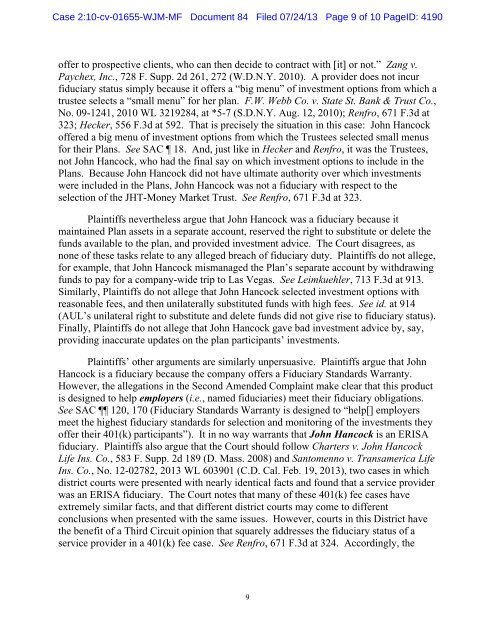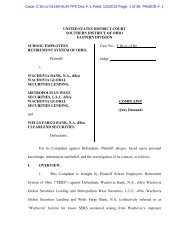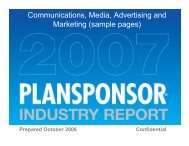Santomenno v. John Hancock Life Ins. Co. - PLANSPONSOR.com
Santomenno v. John Hancock Life Ins. Co. - PLANSPONSOR.com
Santomenno v. John Hancock Life Ins. Co. - PLANSPONSOR.com
Create successful ePaper yourself
Turn your PDF publications into a flip-book with our unique Google optimized e-Paper software.
Case 2:10-cv-01655-WJM-MF Document 84 Filed 07/24/13 Page 9 of 10 PageID: 4190offer to prospective clients, who can then decide to contract with [it] or not.” Zang v.Paychex, Inc., 728 F. Supp. 2d 261, 272 (W.D.N.Y. 2010). A provider does not incurfiduciary status simply because it offers a “big menu” of investment options from which atrustee selects a “small menu” for her plan. F.W. Webb <strong>Co</strong>. v. State St. Bank & Trust <strong>Co</strong>.,No. 09-1241, 2010 WL 3219284, at *5-7 (S.D.N.Y. Aug. 12, 2010); Renfro, 671 F.3d at323; Hecker, 556 F.3d at 592. That is precisely the situation in this case: <strong>John</strong> <strong>Hancock</strong>offered a big menu of investment options from which the Trustees selected small menusfor their Plans. See SAC 18. And, just like in Hecker and Renfro, it was the Trustees,not <strong>John</strong> <strong>Hancock</strong>, who had the final say on which investment options to include in thePlans. Because <strong>John</strong> <strong>Hancock</strong> did not have ultimate authority over which investmentswere included in the Plans, <strong>John</strong> <strong>Hancock</strong> was not a fiduciary with respect to theselection of the JHT-Money Market Trust. See Renfro, 671 F.3d at 323.Plaintiffs nevertheless argue that <strong>John</strong> <strong>Hancock</strong> was a fiduciary because itmaintained Plan assets in a separate account, reserved the right to substitute or delete thefunds available to the plan, and provided investment advice. The <strong>Co</strong>urt disagrees, asnone of these tasks relate to any alleged breach of fiduciary duty. Plaintiffs do not allege,for example, that <strong>John</strong> <strong>Hancock</strong> mismanaged the Plan’s separate account by withdrawingfunds to pay for a <strong>com</strong>pany-wide trip to Las Vegas. See Leimkuehler, 713 F.3d at 913.Similarly, Plaintiffs do not allege that <strong>John</strong> <strong>Hancock</strong> selected investment options withreasonable fees, and then unilaterally substituted funds with high fees. See id. at 914(AUL’s unilateral right to substitute and delete funds did not give rise to fiduciary status).Finally, Plaintiffs do not allege that <strong>John</strong> <strong>Hancock</strong> gave bad investment advice by, say,providing inaccurate updates on the plan participants’ investments.Plaintiffs’ other arguments are similarly unpersuasive. Plaintiffs argue that <strong>John</strong><strong>Hancock</strong> is a fiduciary because the <strong>com</strong>pany offers a Fiduciary Standards Warranty.However, the allegations in the Second Amended <strong>Co</strong>mplaint make clear that this productis designed to help employers (i.e., named fiduciaries) meet their fiduciary obligations.See SAC 120, 170 (Fiduciary Standards Warranty is designed to “help[] employersmeet the highest fiduciary standards for selection and monitoring of the investments theyoffer their 401(k) participants”). It in no way warrants that <strong>John</strong> <strong>Hancock</strong> is an ERISAfiduciary. Plaintiffs also argue that the <strong>Co</strong>urt should follow Charters v. <strong>John</strong> <strong>Hancock</strong><strong>Life</strong> <strong>Ins</strong>. <strong>Co</strong>., 583 F. Supp. 2d 189 (D. Mass. 2008) and <strong>Santomenno</strong> v. Transamerica <strong>Life</strong><strong>Ins</strong>. <strong>Co</strong>., No. 12-02782, 2013 WL 603901 (C.D. Cal. Feb. 19, 2013), two cases in whichdistrict courts were presented with nearly identical facts and found that a service providerwas an ERISA fiduciary. The <strong>Co</strong>urt notes that many of these 401(k) fee cases haveextremely similar facts, and that different district courts may <strong>com</strong>e to differentconclusions when presented with the same issues. However, courts in this District havethe benefit of a Third Circuit opinion that squarely addresses the fiduciary status of aservice provider in a 401(k) fee case. See Renfro, 671 F.3d at 324. Accordingly, the9







